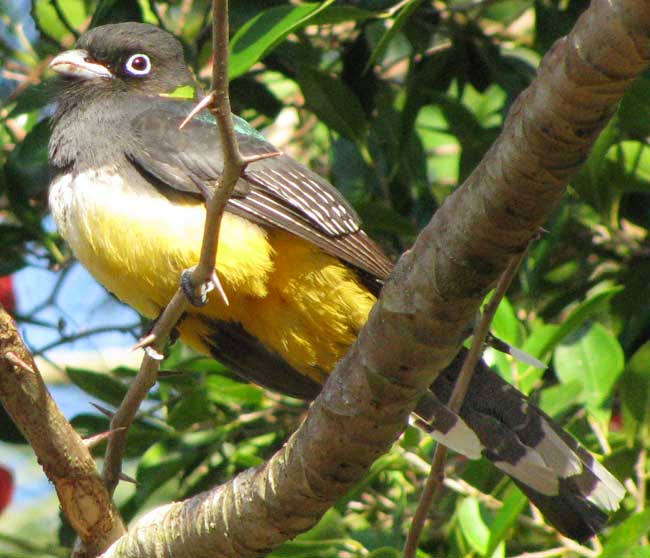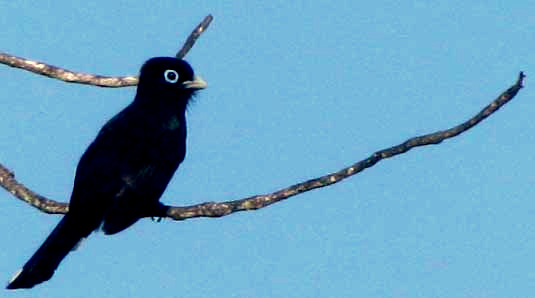Excerpts from Jim Conrad's
Naturalist Newsletter

from the February 20, 2011 Newsletter issued from Hacienda Chichen Resort beside Chichén Itzá Ruins, central Yucatán, MÉXICO; limestone bedrock, elevation ~39m (~128ft), ~N20.676°, ~W88.569°
BLACK-HEADED TROGON
Trogons are chunky, small-beaked, tropical birds a little smaller than Pigeons, and much more boldly patterned. They tend to perch unmoving in deep shadows, occasionally flitting out and quickly nabbing a fruit, then returning to the shadows to eat. Our common trogon here is the Violaceous Trogon, shown at www.backyardnature.net/yucatan/v-trogon.htm.
In that picture, notice the tail's "bar coding" -- a few large white spots separated by more numerous, narrow "zebra stripes." Compare that pattern with what's on the tail of the trogon seen this week at the top of this page. The big white spots are about the same but narrow zebra stripes are practically few.
Among trogons, of which nine are listed for Mexico (including the famous Resplendent Quetzal, which is a trogon with a very long tail), tail bar-coding is important, and in the field the presence or absence of zebra lines is the main way to distinguish this week's Black-headed from the Violaceous.
The eyerings also differ between the species. In the picture you might notice a very slight blue tinge to the bird's eyering. The male Violaceous' eyering is yellow, while the female Violaceous' eyering is broken into two white crescents, one before and one behind the eye. Violaceouses are about an inch smaller, too, but size differences are hard to judge in the field.
Most trogon species are much more different from one another than these two are. When you see two such similar species you can guess that they are very closely related, possibly "sister species" that have arisen from a common ancestral species.
Black-headed Trogons are distributed from southeastern Mexico south to northern Costa Rica. The bird in the picture was perched on a spiny Bougainvillea stem, a gob of fig fruit stuck to his lower mandible, for he was helping finish off this season's crop of figs from the Chinese Banyan in which last week we saw the toucans. Now the figs are eaten up and the toucans seem to be gone.
Actually several bird populations seem to have shifted about lately. For the last year White-winged Doves were uncommon around the Hacienda, while White-tipped ones were seen daily. Suddenly White-wings are abundant, constantly cooing their Who-cooks-for- yoooooo... ? call. Similarly all year, Blue-crowned Motmots appeared here only sporadically, while Turquoise-browed Motmots were seen every day. For the last couple of weeks, Blue-crowns have outnumbered Turquoise-brows.
from the June 12, 2011 Newsletter issued from Mayan Beach Garden Inn 20 kms north of Mahahual; Caribbean coastal beach and mangroves, ~N18.89°, ~W87.64°, Quintana Roo state, MÉXICO
EYE IN THE SKY, SKY IN THE EYE
Especially if you know a little about Mexican birds, see if you can identify what KIND of bird is shown below:

I'd approached a shadowy clump of trees from which two birds were loudly calling chuk, chuk, chuk-chuk-cho-cho-cho-cho-cho-cho!... For several minutes they stayed hidden. Then, just as I was giving up and leaving, the one in the picture flew out and perched on a snag in the mangroves. Seeing the bird's stocky body, long, square-tipped tail and short beak, it was clearly a trogon. But what trogon is all black, and what trogon is graced with such a spectacularly blue eyering?
It's the Black-headed Trogon, sometimes lumped with the Citreoline Trogon. It's TROGON MELANOCEPHALUS.
Actually, we saw a Black-headed Trogon up at Hacienda Chichen this February. It's shown from the front at www.backyardnature.net/yucatan/trogon.htm.
In that picture you can see that that bird's eye ring is a much paler blue. I'm guessing that during breeding season the blueness intensifies. Also I'm guessing that our current bird is a female, for the backs and tail-tops of male Black-headeds are greenish, and their rumps are bluish, while our bird seen from behind looks all black. That, or somehow the lighting obscures the bluishness and greenness. That could be, because I read that the female's eye ring is duller than the male's, and I can hardly imagine a bluer eye ring than this one's.
When our black-backed bird dove toward something below it, for a split second the bird's bright yellow bottom flashed against the mangroves' deep greenness, and that was pretty.